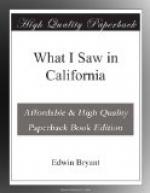“In the valleys of the rivers which come down from the great Snowy Mountains are vast bodies of pine, and red-wood, or cedar timber, and the streams afford water power to any desirable amount.
“The whole country east of the San Joaquin, and the water communication which connects it with the lakes, is considered, by the best judges, to be particularly adapted to the culture of the vine, which must necessarily become one of the principal agricultural resources of California.”
The Salinas River empties into the Pacific, about twelve miles above Monterey. Bear River empties into the Great Salt Lake. The other streams of California are all small. In addition to the Great Salt Lake and the Utah Lake there are numerous small lakes in the Sierra Nevada. The San Joaquin is connected with Tule Lake, or Lake Buena Vista, a sheet of water about eighty miles in length and fifteen in breadth. A lake, not laid down in any map, and known as the Laguna among the Californians, is situated about sixty miles north of the Bay of San Francisco. It is between forty and sixty miles in length. The valleys in its vicinity are highly fertile, and romantically beautiful. In the vicinity of this lake there is a mountain of pure sulphur. There are also soda springs, and a great variety of other mineral waters, and minerals.
The principal mountains west of the eastern boundary of California (the Rocky Mountains) are the Bear River, Wahsatch, Utah, the Sierra Nevada, and the Coast range. The Wahsatch Mountains form the eastern rim of the “great interior basin.” There are numerous ranges in this desert basin, all of which run north and south, and are separated from each other by spacious and barren valleys and plains. The Sierra Nevada range is of greater elevation than the Rocky Mountains. The summits of the most elevated peaks are covered with perpetual snow. This and the coast range run nearly parallel with the shore of the Pacific. The first is from 100 to 200 miles from the Pacific, and the last from forty to sixty miles. The valley between them is the most fertile portion of California.
Upper California was discovered in 1548, by Cabrillo, a Spanish navigator. In 1578, the northern portion of it was visited by Sir Francis Drake, who called it New Albion. It was first colonized by the Spaniards, in 1768, and formed a province of Mexico until after the revolution in that country. There have been numerous revolutions and civil wars in California within the last twenty years; but up to the conquest of the country by the United States in 1846, Mexican authority has generally been exercised over it.
The following description of the political and social condition of Upper California in 1822 is extracted and translated from a Spanish writer of that date. I have thought that the extract would not be uninteresting:—




